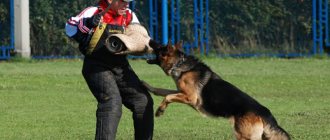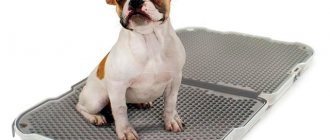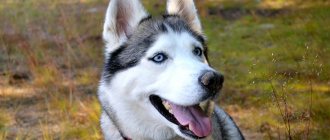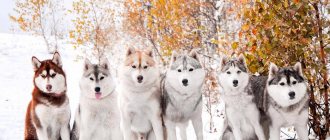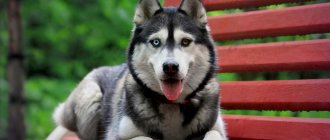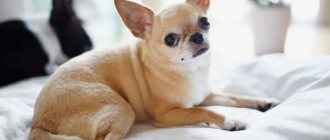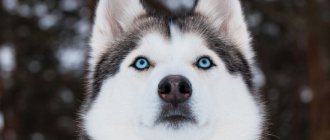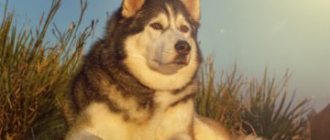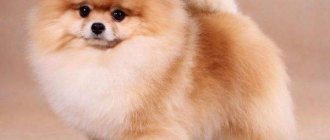We got a female husky who was one year old. We have our own house and this dog is not small, so I want to know if it is possible to keep it in the yard, on a chain?
No. Husky is not a breed that can be kept on a chain in the yard. This is not a guard dog. It is allowed to be kept outside, but in a spacious enclosure. It will become the dog's personal territory. The enclosure must be placed so that the pet from it can see everything that is happening in the yard and observe family members. A booth should also be placed there. Its roof should be flat because huskies love to sit on it and watch everything around them. You can insulate a dog house with a thick layer of straw.
Let us remind you that huskies are polar sled dogs that are intended for transporting goods. They are strong and resilient, active and very hardworking. Such dogs simply cannot live without physical activity. Therefore, even a dog living in an enclosure needs to be let out periodically, walk with it, swim, run, play. Joint physical activity with the owner will be the best way to maintain the dog's health. That is why huskies should be owned by those people who themselves love sports and any physical activity. The pet will be very happy to support its owner on a morning jog, in outdoor games, riding a motorcycle, and skiing. Representatives of this breed can be harnessed to a sled and have fun in the snow. The dog must be exercised every day, otherwise it may become aggressive. Animal psychologists state that huskies, deprived of the opportunity to run for a long period of time, become neurotic. This should be taken into account by people who place such a dog in an apartment.
As for the guarding abilities of representatives of the breed, they are very difficult to develop, even if you start from puppyhood. These dogs are not intended for protection. They will not protect their owner, will not protect him in case of danger.
Another significant drawback of huskies is their stubbornness and willfulness. They can exhibit such traits even when they are devoted to their owner. Representatives of the northern breed are smart, undemanding in care, and balanced. They are called intelligent workaholics.
Huskies, like representatives of other breeds, need the most comfortable living conditions and proper care.
Without this, it is impossible to raise a healthy and happy dog that will be a loyal friend and companion.
Pets are suitable for keeping in an apartment and on the street, but it is better not to put them on a chain.
How to choose a husky puppy, at what age to get it and what to prepare for its arrival?
It is better to get a puppy at 1.5–2 months of age, purchasing it from a specialized nursery. When choosing a future four-legged family member, you need to pay attention to:
- condition of the coat - it should be shiny and uniform;
- tail - it should be smooth, without creases;
- bone strength;
- correct bite;
- neck posture;
- muzzle (it must have the mandatory attributes of a husky - a light mask and dark glasses).
Before going to the nursery, it is worth studying the description of the exterior of this breed. This will make the choice much easier. It would be a good idea to ask the nursery staff for a certificate of activity and documents for the pet. If possible, look at the parents of the baby you like. Various disabilities, including mental ones, are often inherited. The puppy’s behavior will also tell the future owner a lot. If the animal is lethargic and passive, it is better not to buy it.
You need to carefully prepare for the arrival of a puppy in your home. To place your baby comfortably you need:
- select a secluded, cozy place for rest and sleep - the bed should be plastic and the mattress should be durable so that the dog does not chew it;
- buy bowls for food and water and a stand for them - it is better to choose metal or iron containers;
- purchase hygiene products: zoo shampoo, a brush with rounded teeth, a finger toothbrush and toothpaste;
- buy food after consulting with your veterinarian.
How to brush your teeth?
There is an opinion that since huskies have good health, there is no need to take care of the teeth and the general condition of the oral cavity of these dogs. This is wrong. The quality of primary food processing and its preparation for digestion depends on the condition and health of the teeth.
Poorly chewed food can lead to serious problems associated with your pet's gastrointestinal tract..
Diseased teeth provoke the formation and development of bacteria and toxins, which can get not only into the dog’s nose and ears, but even into the heart and lungs, and cause the development of inflammatory processes.
This is an indication that your husky has dental problems.:
- unpleasant odor from the mouth;
- redness of the gums;
- swelling of the muzzle:
- the appearance of blood or pus in saliva;
- noticeable damage to teeth;
- exposure of tooth roots.
To avoid such problems, it is necessary to take care of your pet’s teeth from puppyhood, preventing the appearance of plaque, which can lead to periodontal disease.
It is necessary to brush your pet's teeth daily using a special brush and toothpaste designed for dogs . It is important to ensure that the movements of the brush are not directed across the axis of the tooth.
You also need to regularly give your dog bones, tendons and other chewable objects - they help mechanically clean the teeth, which prevents the formation of plaque and tartar.
Features of keeping in a private house
Huskies are sled dogs; they naturally have endurance and adaptability to negative natural conditions. Modern dogs are increasingly used as companions and participants in dog shows. If you plan to keep a husky in a country house, you need to first find out whether it is possible to keep the dog in an enclosure, or whether he will feel uncomfortable on the street.
At home or in an enclosure?
These dogs do well when kept in the yard. They can live outside all year round. Despite the fact that huskies can easily withstand even the most severe frosts and are not afraid of heavy snowfalls, the sun is destructive for them. This is due to the characteristics of the coat. The maximum duration a husky can stay under the scorching rays of the sun is 1.5 hours, so when building an enclosure you need to think about a canopy that will reliably protect its occupant from unfavorable weather conditions.
Chain-link mesh is not the best option for fencing an enclosure. The freedom-loving dog will gnaw through it in a matter of days and break out. In this case, he can be seriously injured on the sharp edges of the mesh. It is recommended to fence the enclosure with a high steel mesh with strong, thick rods. These dogs love to dig. To prevent this from happening, the ground around the pet’s home should be deepened and the lower part of the fence should be cemented.
Are Huskies chained?
Most dog handlers and experienced breeders are against keeping representatives of this breed on a chain. These are not guard dogs. They are energetic, cheerful and freedom-loving. Putting such a pet on a chain means dooming it to suffering and torment. A tethered animal can become severely depressed. If you plan to keep a dog on a chain, it is better to opt for another breed, such as a shepherd.
How to feed
The basic rule of feeding a husky that must be followed is that the diet must be balanced, based either on natural products or on industrial food, since mixed nutrition is unacceptable.
With a natural diet, the pet must be given:
- lean meat;
- offal;
- sea fish;
- eggs;
- dairy products;
- animal and vegetable fats;
- vegetables, fruits, herbs;
- cereals;
- "sugar" bones.
As an additional source of calcium, you should include a small amount of eggshells in your dog's menu.
Banned for Huskies:
- confectionery, sweets, chocolate;
- grapes and raisins;
- pork, lamb;
- pickles, smoked meats;
- citrus;
- potato;
- milk;
- spicy, salty food;
- tubular bones;
- River fish;
- bread and baked goods;
- pasta;
- legumes;
- salo;
- nuts.
The diet of an adult dog must contain at least 70% meat or meat products.
In cases where feeding is based on industrial feeds, you should buy products of at least premium class.
The most popular foods suitable for representatives of this breed are Nutra Gold, Advance, Purina Pro Plan (Sensitive Salmon, Medium Robust Health, Medium Robust, Medium Puppy Sensitive), Royal Canin, Happy Dog (Maxi Baby and Nature Croq).
Is it possible to keep a Husky dog in a city apartment?
The lack of a private home is not a reason to refuse to buy a husky. These dogs do well in an apartment. City dwellers who dream of having such a pet should know that a husky is not a couch potato. An energetic dog living in cramped conditions needs increased physical activity. If a pet is unable to expend the energy accumulated during the day, this will negatively affect not only its mood, but also its appearance and health.
- Provide your dog with enough toys.
- Walk your tailed friend regularly. An animal may chew furniture and play pranks due to idleness. If you organize active leisure time for him, this problem can be avoided. You need to walk your dog daily and for a long time. During walks, you need to let the dog run around and play enough.
- Raise a pet. It is necessary to engage in education from a very early age. The sooner the puppy learns the rules accepted in the house, the fewer unpleasant surprises his stay in the family will bring. The child needs to be explained in a confident but friendly voice that he should not chew the furniture. These smart dogs usually learn new information quickly, so you won't need to repeat the same request over and over again.
What to do during the molting period?
One of the unpleasant aspects of living with a dog in an apartment is shedding. These pets shed twice a year. Coat change in most cases takes about 3 weeks. During this period, the dog completely loses the undercoat layer. Huskies tend to shed profusely. If an animal is kept at home all year round, in the absence of a pronounced change of seasons, it will shed constantly, but quite sparingly.
During the shedding process, your dog's coat needs to be properly cared for. Husky care at this time consists of daily brushing. If you ignore this procedure, the wool will fall off and literally fill the entire house. It is better to comb your pet with a rake comb (see photo). Unlike slicker brushes and furminators, they carefully comb out the fur without tearing out or breaking off hairs.
How to ensure sufficient physical activity?
An active pet husky needs to burn off its energy regularly. Walking outside is great for this. If the pet is not yet trained, it should only be walked on a leash. It should not be left unattended in unfenced areas. In winter, dogs will enjoy sled riding and skijoring, or sled skiing. Huskies will also appreciate weight-pulling, agility, walking and cycling.
As for water sports, it is better to avoid them, since these dogs are completely unsuited to them. When choosing the type of physical activity, it is necessary to take into account the natural characteristics of these dogs. Until the age of one year, the formation of joints, ligaments and bones has not yet been completed, so during active movement there is a high probability of injury to the pet. Puppies should not be allowed to run up steep stairs. You can run long distances with your dog only after he is 3 months old. Harness running without load is allowed from the age of 9 months.
Grooming. What is husky fur an indicator of?
Representatives of this breed cannot be cut or trimmed; the husky's coat only needs to be combed every 2-3 days with a slicker or brush, and during seasonal shedding daily with a comb, comb and furminator.
First, the coat must be moistened with water, then combed along the hair growth from head to tail, and then in the opposite direction. When all the wool has been combed against the hair growth, you need to lightly brush it while styling it. At the very end, you should comb the tail.
Regular brushing eliminates the possibility of matting and tangles.
With proper coat care, females shed 2 times a year, males - 1 time every 1.5 years.
Husky fur has a unique structure, thanks to which these dogs not only tolerate frosts down to -60 ° C without problems, but are also able to warm people with their warmth, something that Eskimos often used in the past.
According to scientists from the University of Alaska, the husky's coat can help detect mercury pollution in the environment, being an indicator of the presence of mercury..
Feeding the Husky
To raise your pet to be energetic, cheerful and healthy, it must be fed properly. The nutrition of puppies and adult animals has its own characteristics. Feeding babies is aimed at the growth and formation of internal organs, while feeding mature dogs is aimed at maintaining muscles. If there is a deficiency of necessary micro- and macroelements, the puppy will lag behind in development, and the adult husky will deteriorate in appearance and health.
What to give a puppy?
Puppies require more frequent feeding than adult animals. Until the age of two months, the pet should be fed 6 times a day, from 2 to 4 months - 5 times, in the next 2 months - 4 times. Starting from the age of six months, the dog is transferred to 3 meals a day. 10 month old dogs only need to eat twice a day. It is advisable to give puppies dry food soaked in water or meat broth. When choosing finished products, you should give preference to high-quality brands. Low quality food will negatively affect the appearance and health of the animal.
How to feed an adult dog: diet and diet
It is difficult to organize proper nutrition for a dog by choosing natural food. You need to choose products very carefully. They must be fresh and of high quality. Up to 60% of a dog's diet should consist of raw or scalded meat (except pork and lamb): beef, rabbit, turkey. It is better not to use chicken, as it is a highly allergenic product. Fatty meat is excluded from the pet's menu.
The dog can be given boiled boneless sea fish and boiled or raw egg yolk several times a week, adding it to oatmeal, buckwheat or rice porridge. Porridge can be cooked in vegetable, meat or fish broth. The husky's diet should include low-fat dairy products and raw or boiled vegetables - carrots, spinach, beets, lettuce, pumpkin, zucchini, cucumbers.
Education and training
Raising and training a pet should be done from an early age. To make a dog obedient, he needs to show him who’s boss on the very first day of his stay in a new family. Following a number of rules will help you raise a dog:
- Give instructions in an even and confident voice.
- Start training with basic commands: “Place”, “No”, “Near”, “To me”, “Sit”, “Lie down”, “Voice”.
- Do not humiliate or beat an animal that refuses to follow the owner’s orders. As punishment, you need to take the dog by the withers, press it to the floor and release it when it stops resisting and relaxes.
- Reward the tailed student for obedience with praise and treats.
- Do not prohibit communication with relatives.
- Do not carry the animal in your arms.
- Do not repeat the same command many times in a row.
- If you react violently to the appearance of strangers, ignore the dog.
How to care for a husky in a private home?
It is not enough to simply provide optimal living conditions for your pet. It is important to know how to care for a husky in a private home
to prolong the life of your pet and maintain its health at a high level.
Husky care in a private home
includes the following points:
- Feeding. 3/4 of the diet should consist of food made from natural meat. You also need to add organ meats, vegetables and cereals. 10% of the diet consists of fermented milk products with zero or low fat content.
- Walking. Regular, frequent and long lasting. Just walking is not enough. The pet needs to run a lot.
- Vaccination. On the street, the animal is exposed to dangers in the form of numerous bacteria that provoke infectious diseases. Therefore, huskies living on the street must receive a course of necessary injections!
- Training and education. If the point is not fulfilled, the husky will turn into a serious kaposter, who will have to be cleaned up every day.
- Hygiene. The animal needs examinations, combing, bathing, and haircuts. Your pet's fur is thick, so summer shedding will leave large clumps throughout the house.
Huskies are clean and proud canines. They won’t get dirty again and stick their nose where it doesn’t belong. Therefore, caring for a husky in a private home
will not bring difficulties to the owner, but still, it is extremely necessary to prolong the life of the pet.
What temperature can Huskies withstand?
Huskies and other northern sled dogs feel better outside in cold winters than in hot summers: they do not freeze at sub-zero temperatures - they are protected by a warm two-layer fur coat. -20–30 °C is not a problem for them, and huskies can be kept outside if you are ready to equip a warm kennel and create a comfortable life for the dog.
Basic rules of care
Huskies are unpretentious dogs.
They do not require complex care and all manipulations necessary to maintain the external attractiveness and health of the pet are reduced to a set of hygiene procedures, including:
- the washing up;
- combing;
- trimming nails;
- cleaning teeth and ears;
- rubbing the eyes.
The dog must also be vaccinated according to schedule and treated against fleas, ticks and helminths.
Necessary conditions for keeping a husky outdoors
You will need to build a material base for the pet to live in the yard. This includes:
- sufficient space for building an enclosure (it will take at least 5–7 m2);
- the ability to securely fence the enclosure and equip it with a warm booth of a size suitable for a husky;
- a variety of natural food or high-quality commercial food;
- constant access to clean drinking water (necessarily heated in winter).
The second component of a dog’s healthy lifestyle is psychological comfort. To keep your pet healthy and cheerful, he needs:
- daily walks, active games and exercises;
- It is highly desirable to play sports;
- a complete general training course (you can do additional training), if possible adapted for sled dogs (the dog handler must take into account the characteristics of the breed - independence, tendency to make decisions independently);
- your friendship, love and attention.
Huskies are very active dogs and, even if they live on the street , they cannot spend all their free time in an enclosure, no matter how convenient it is for living.
Pros and cons of keeping a husky in an enclosure
Statistically, kennel dogs:
- healthier: they are less likely to experience osteopathic problems, allergies, and respiratory system diseases;
- better “dressed”: they do not shed all year round, they have denser and more beautiful coat.
Keeping a husky outdoors also solves the problem of cleaning, which must be done daily (and during the molting period, several times a day) by owners whose dogs live in their homes.
There are also difficulties:
- an enclosure dog is not constantly near the owner, like an apartment dog, so you need to allocate a lot of free time to communicate with it;
- building an enclosure that is suitable for the size and functionality of a husky requires effort, money and time.
You should not place a husky in an outdoor enclosure with the expectation that the dog will guard the house and property. This is unlikely. Northern sled dogs can, under favorable circumstances, display protective qualities, considering the territory of the yard to be their own. Take this as a pleasant bonus, without particularly counting on your pet: huskies are not guard dogs. A representative of any service breed will perform a guard function much better.
equip an outdoor enclosure for your husky if you are guided by the desire to give your dog a long, healthy life in the fresh air. At the same time, you need to be aware that such an animal will need perhaps even more attention than a domestic animal. In any case, in an apartment you can show your pet your love while going about your business (for example, petting it and watching TV at the same time). The time spent together with the enclosure dog should belong entirely to her.
How to properly clean your ears
Huskies have erect ears, so there are much fewer problems with them than breeds with floppy ears . However, it is necessary to monitor their health and clean them regularly.
If your pet's ears become inflamed, make a squelching sound, or smell unpleasant, you should contact your veterinarian.
You need to clean your dog's ears on average once every 2-3 weeks, for this you need:
- lay the pet on its side;
- drop a special lotion into his ear;
- massage the auricle for 1-2 minutes, stimulating the softening of earwax and dirt;
- Wipe your ear with a cotton pad soaked in boiled water or the same lotion, removing wax and dirt.
You should not use cotton swabs to clean your ears, as this can push dirt and wax deeper into the ear.
Is it possible to keep a husky on a leash?
The answer to this question is the champion of brevity: no. Neither a husky nor any other companion dog should be permanently chained. And is it possible to teach a husky to guard , even if you live in a private house? Chain confinement may be necessary for guard dogs whose job is to protect military bases and supply depots that might be infiltrated by intruders.
Animals living on a leash do not have the opportunity to move sufficiently and, if they are chained young (during the period of active bone development), have problems with their hind limbs. In addition, a chain dog is unlikely to have a stable psyche. In general, this option is not for humans.
Huskies are not kept on a chain ; the only exception that can be made is a short-term need to limit the dog’s movement, a last resort.
How to improve the street life of a husky
At the stage of constructing the enclosure, this will require dedication! But if you equip your home with high quality, it will not need restoration for a long time.
Construction of an aviary
5 m2 is the minimum allowable area that an enclosure can occupy in the yard. It must be equipped with:
- a source of artificial light in case there is not enough sunlight;
- reliable waterproof roof;
- dense flooring located at an angle of more than 90 ° to the vertical so that rainwater can flow freely from it into the prepared gutter;
- three blank walls protecting from the wind, and one visible - made of thick metal mesh or rods.
Thin building meshes (for example, Chainlink) are not suitable for huskies: the dog's stubbornness combined with a strong jaw works wonders. There is a risk in a few hours of discovering an open enclosure, a dug tunnel to the neighbors and the absence of a dog in sight.
What kind of doghouse is needed for a husky?
The size of a kennel for an adult husky can be calculated based on the breed standard. The length of the edge of the house should be equal to the height of the dog plus 10–15 cm. They are needed so that your pet can sit comfortably without harm to the skeleton, and his paws do not become numb. A kennel that is too large is bad: most likely, it will not be warm enough. A middle ground is needed: the height of the average male husky is about 60 cm, that is, the width of the booth will be approximately 75 cm.
The ideal doghouse for a husky to live outside in winter must have:
- windproof walls without cracks (for northern regions, the best option is two-layer wooden panels with foam insulation);
- a folding or removable roof (without it, thorough cleaning is impossible);
- cozy bedding.
It is advisable to make a folding canopy at the entrance to the booth so that it retains heat better in cold weather.
Accustoming a Husky puppy to an enclosure or cage
A husky puppy that you keep outside will get used to the kennel and enclosure faster if you put him there as a baby. At first, you should not close the door and leave the dog inside for a long time - a few minutes or tens of minutes are enough. Let the animal be able to get in and out freely at first; you can lock it up later.
Form positive associations for your pet with the yard and enclosure. Food rewards that work well include feeding treats inside. You can put clean water in the enclosure so that the puppy can go in there on his own when he is thirsty. Provide him with toys that he can chew on.
Here's what you shouldn't do:
- do not drag your baby husky into the enclosure by force;
- do not lock him there, leaving him alone;
- do not punish him in the enclosure - it is better for the dog to avoid punishment altogether than to decide that the enclosure is a place for guilty people.
Gradually increase the amount of time your husky puppy spends outside alone. At 3–4 months you should not leave him alone in the enclosure for more than an hour; by six months this time can be increased to three hours. There are also rules for adult huskies. A dog left in a crate for more than half a day every day will suffer without exercise and your attention. Even if you don’t have the energy or time for proper exercise, let your pet run around the yard and play several times a day.
The same methods are also used, if necessary, to accustom a husky puppy to a crate in an apartment . By the way, many owners are against cages, believing that it limits the freedom of the animal. They are partly right: the dog should not be kept locked up all the time. But sometimes this is necessary even for a pet (for example, if it gets underfoot while cleaning), so it is better to teach the puppy to stay in the crate for several hours. If the crate does not cause negative associations in the dog, it does not perceive it as punishment or deprivation and rests calmly in it.
How to bathe correctly and how often it should be done
The husky's coat is capable of self-cleaning, so representatives of this breed do not need frequent washing. The only thing you need to do regularly is wash the paws and belly of a dog living in an apartment after every walk.
You need to thoroughly wash your pet no more than once a quarter, using shampoo that matches the type and color of the coat .
First, you should thoroughly wet the topcoat and undercoat, then apply shampoo, lather it and rinse thoroughly with water, making sure that it does not get into the pet’s ears and eyes.
Before bathing your puppy for the first time, you need to lay a rubber mat on the bottom of the bathtub so that the dog’s paws do not slip..
After bathing, the dog should be dried with a terry towel and thoroughly dried with a hairdryer so that the undercoat does not remain wet.
